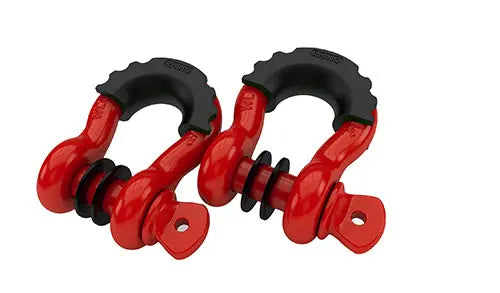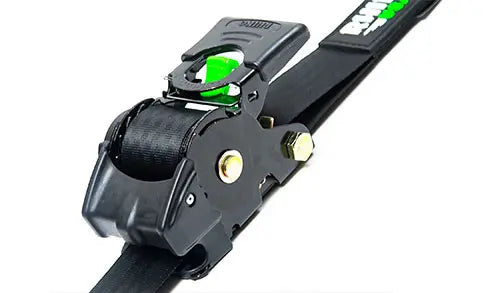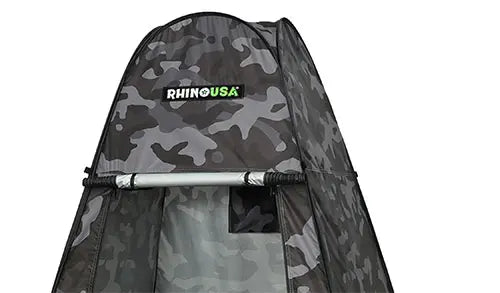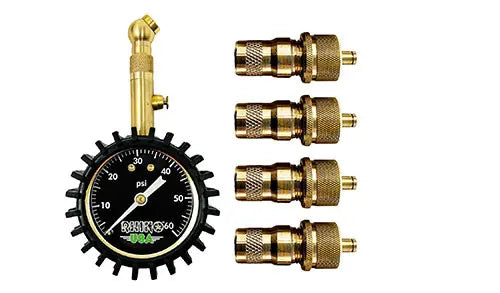
Can Am vs Polaris: UTV Legends Compared
There are two brands that contend for supremacy in the sport UTV (aka side-by-side or SXS) market in the production UTV realm with massive horsepower and monstrous torque. These two UTV industry heavyweights are provided by Polaris and Can-Am. The Can-Am Maverick X3 X rs and Polaris RZR XP Turbo Dynamix are the vehicles we're referring to. This competition between the two machines isn't just about having the strongest power; it's also about having the best suspension, the most comfort riding experience, the best 4WD, the best handling and steering wheel, and other crucial characteristics. Whoever has the best high performance between the two vehicles ultimately wins. Fortunately at Rhino USA, we've tested UTV repeatedly over the years.
In the world of off-roading and higher speeds rough terrain performance, drivers don't want to compromise. The days when the Yamaha Rhino topped the supercar segment are long gone. Nowadays, UTV enthusiasts have clear objectives when it comes to the Can Am and the Polaris RZR:
- They want comfort
- They want high speeds
- They want high performance
- They want reliability
Can any UTV meet their expectations? The truth is that you'll need to compromise. The Can Am maverick and the Polaris rzr are the two machines that fit the bill the best with as little compromise as possible. They don't choose between power and cost saving. They are capable of reaching high performance. So we'll review which UTV SXS is the best bet for your high speed.
Can Am vs Polaris - Two brands for power
Both Polaris RzR xp Turbo and Can Am Maverick X3 launched in the snowmobile industry, creating room for competition and exciting development. Both vehicles were late to join the UTV market. In 2008, Polaris, taking inspiration from the Yamaha Rhino, introduced the Ranger RZR. This RZR prioritized power and fun without sacrifice. The UTV action magazine welcomed the Ranger RZR with open arms, recognizing the all-around play revolution driven by the RZR platform.
Two years later, Can Am entered the all terrain and UTV market with the Commander 2, a power car designed for high speed. Since then, the development teams of Can Am and Polaris have been competing against each other, until the most recent releases where they both added turbo engines (the Can Am RS Turbo RR and the Polaris RZR Xp turbo). For the sake of this article, we will examine the Polaris RZR XP Turbo (including the RZR XP Turbo S and Polaris RZR Pro XP) and the Can-Am Maverick X3 X RS, two manufacturers of the most potent and quick utility vehicles.
Can Am Maverick & Polaris rzr - Side by side UTV specs
Power struggles
The engines between the Polaris RZR XP Turbo S / RZR Pro XP turbo and the Can Am Maverick X3 turbo RR are both liquid cooled and electronically fuel injected. The Polaris CVT feeds the 168 horsepower engine. For the Can Am maverick, it's a 172 horsepower engine.
The RZR turbo S model introduced a better steering wheel, reducing sloppy experiences. Additionally the RZR 25% power steering boost surpasses the Can Am.
Essentially, an aftermarket module sign could help you take full control of your spark time in tandem with the air/fuel ratio of your vehicle, if you want to maximize performance.
Shocks and suspension 
When it comes to jumps and suspensions, the Polaris rzr is ahead of the game with an enhanced suspension system. When the car is airborne, the computer on board automatically stiffens the fox podium shocks for adjustable suspension. On the other hand, the Maverick x3 default settings turn rough terrain into a rough shocks suspension.
As if suspension wasn't the only problem, the default setting for shocks with the X3 X RS also brings the rear skid plate in contact with the ground. Low ground clearance is part of the design. Comparatively, the combo of adjustable suspension and 4-inch rear ground clearance for the RZR turbo keeps parts alive for a little longer! Hard landings are more comfortable with the RZR xp turbo s thanks to its excellent suspension system.
That being said, the suspension travel with the X3 X RS and the RZR Pro XP is similar, with approximately 2 feet of suspensive travel at each end for both cars. Nevertheless, they both fly well and can take plenty of abuse before the shocks start showing alarming signs.
On the point of suspension travel and obstacles, it's worth mentioning that the X3 Turbo RR has an increased wheel travel, wheelbase and width, helping go over bumps more effectively. Comparatively, the Polaris bring lesser wheel travel, but its adjustable suspension acts as an alternative to wheel travel when it comes to getting over rough terrains. Recommendations for either car is to unload the machines at 6:30 AM and set tire pressure at 13 psi for uneven bumps and whoops.
Tight trails maneuver
Both the Can Am X3 Turbo RR and the Polaris Pro XP are comfortable handling tight and winding trails. Power wise, they are similar in handling. Sound wise, the Can Am is a lot quieter than the RZR Pro XP. If you're riding side by side in the same place, the Polaris could fully mask the X3 Turbo RR.
In Tighter trails, the Pro XP shines through its shorter wheelbase, delivering greater control over cornering.
High speed

Comparing top speed between the RZR and the Maverick X3 X highlights the limitation and performance for the cars. Both the RZR Pro XP and the Turbo RR reach their limit shy of 90. Both remain stable, but the longer wheelbase of X3 X RS turbo enhances the sense of stability. The RZR's shorter wheelbase gives it a twitchy feel at higher speeds, not suitable for less experienced drivers. The aggressive steering wheel ratio in the Polaris can also take away some of the fun of its power, despite its suspension travel and adjustable suspension response.
The low ground clearance on the Can Am Maverick X3 X RS turbo can make landing uncomfortable. But it enhances stability behind the steering wheel at high speed. Besides, the RS Turbo wheels at the rear being one foot closer than the Polaris make a huge difference.
Creature comforts
The Can Am Maverick X3 X Rs 2018 model comes with four-point adjustable seats harnesses, while the Polaris RzR XP Turbo has standard automotive-style seat belts. The Can AM Maverick X3 X brings a leaned-back driver's seat for a more comfortable experience. Yet, the low seating position unfortunately has many blind spots. The driver's head is too low for appropriate visibility. Additionally, the seat is in an awkward spot for the steering wheel. Yet, these can be remedied with aftermarket parts to adjust the seating position and comfort. There's a significant body roll with the Can Am too, which could only be managed by switching the sway bar.
The RzR xp turbo s has considerably less blind spots, offering better visibility. But the higher driver's seat in the Polaris is uncomfortable when cornering. The Polaris rzr xp turbo uses smart suspension shocks to help with the body roll the RzR had in older model UTV. Worth noting, the RZR xp turbo s front wheels and rear wheels stick out past the bodywork, ideal for higher speeds.
The Maverick x3 x rs has standard 14-inch aluminum beadlock wheels, while the RzR turbo prefers alluvium wheels.
With a high volume plastic for LED headlights, skid plate, and taillights, the Can Am Maverick X3 X Turbo RR makes it harder to access parts under the body panels.
Price
Things often start to get uncomfortable when you begin talking about money. These amazingly engineered UTV's have all the bells and whistles but certainly don't carry a small price tag. The cheapest Maverick model from Can Am is the X3 DS Turbo coming in with a starting price of $21,599. The highest spec'ed model from the Can Am Maverick line is the MAVERICK X3 MAX X RS TURBO RR WITH SMART-SHOX 72 which has 200-horsepower and comes in at a whopping starting price of $35,399. On the flip side, Polaris offers the RZR XP 1000 as their "base" model in the lineup starting at $21,899, however, their range goes all the way up to the RZR Pro R 4 which starts at $41,699. Obviously, none of the models offered by Can Am or Polaris are considered "budget" by any means, but you certainly get what you are paying for.
Technology
The Polaris rzr xp turbo s brings a much user-friendlier touchscreen display, letting the driver select Live Valve shocks to display active compression damping, selected mode, G-force, pedal position, steering angle, brake status and diagnostics for high tech real-time control. Full ride command solution integrated within the interior design of the RZR; at this point you can diagnose issues and improve the ride in a few clicks. There's also the option for a rear view camera and full GoPro on the RzR turbo, which can be part of the Ride Command feature.
Comparatively, the Maverick x3 has a standard with a rear view mirror, push-to-start engine, DPS three modes power steering and Eco mode. Power steering on the Maverick X3 Turbo is a little easier to handle than on the RzR. There's no sign of the unique ride command system that drivers can enjoy in the Polaris. We can only hope for better tech in the future on the part of the Can Am RS turbo.
Featured Product: Rhino USA UTV Wheel Chock Tie Down Kit

Bring your UTV to the next level with Rhino USA products
Whether you're tempted to push your UTV to the limits or you want to try out new rough terrains, we recommend investing in Rhino USA recovery gear and tie down to ensure you can still make the most of your can Am or Polaris! Unsure which kit is best suited for your adventure? We did share prev post tips in our blog so feel free too explore the best ideas!
- UTV Kinetic Recovery Kit
- Retractable Ratchet Straps
- Off-road gifts for enthusiasts
- Rollover protection in UTV
We hope you enjoyed reading our comparison of the ultimate side-by-sides Can Am Maverick and Polaris RZR. Make sure to check out our Rhino USA store for the best UTV recovery gear and off-road accessories that are a must-have for any UTV enthusiast!
 FAQ's
FAQ's
Are Can Am UTVs more reliable than Polaris UTVs?
Both Can Am and Polaris UTVs are known for their reliability, but there can be differences between specific models and features. It's important to research and read reviews from other UTV owners to get an idea of the reliability of different models. Regular maintenance and proper use and storage can also impact the reliability of a UTV.
Which brand has better aftermarket support, Can Am or Polaris?
Both Can Am and Polaris have a wide range of aftermarket parts and accessories available for their UTVs. However, the availability and variety of aftermarket support can vary depending on the specific model and brand. It's important to research the availability of aftermarket support for the specific UTV you are considering to ensure that you can find the parts and accessories you need to customize and enhance your vehicle.
- Choosing a selection results in a full page refresh.








